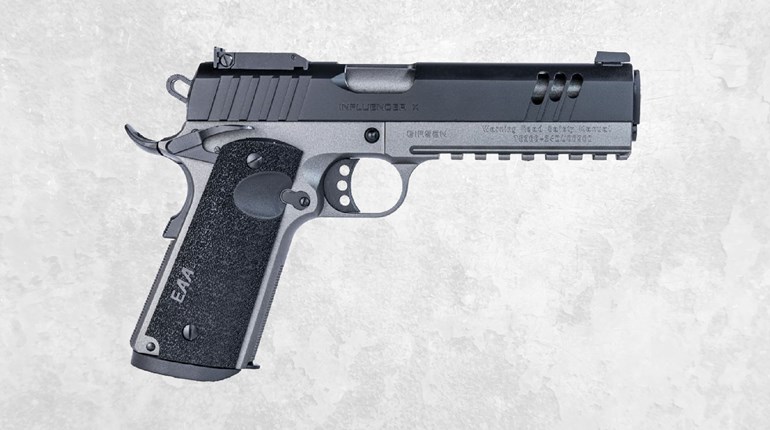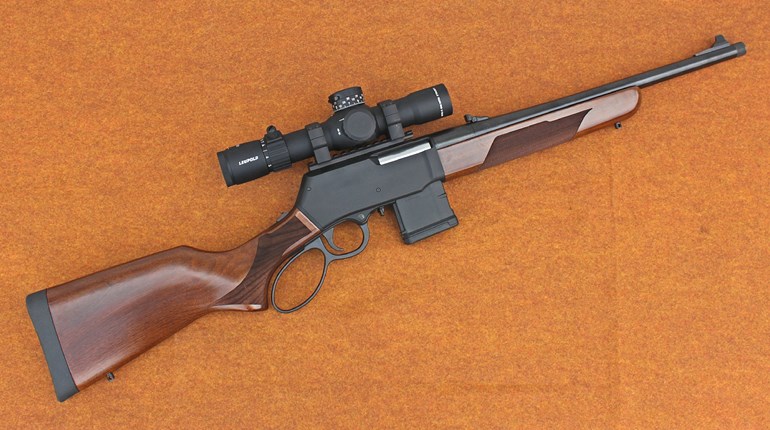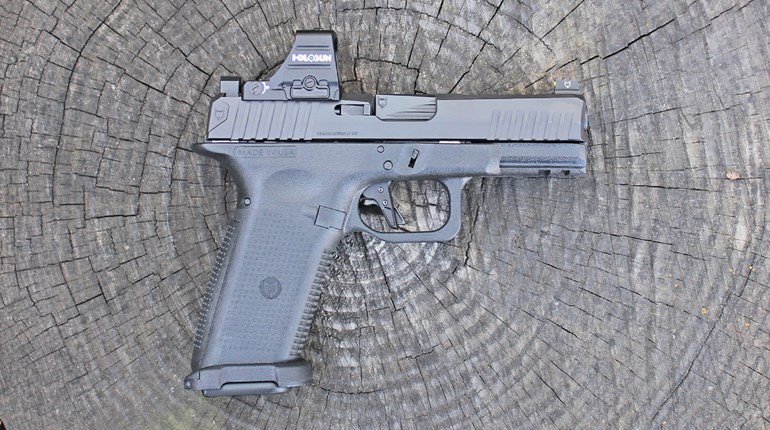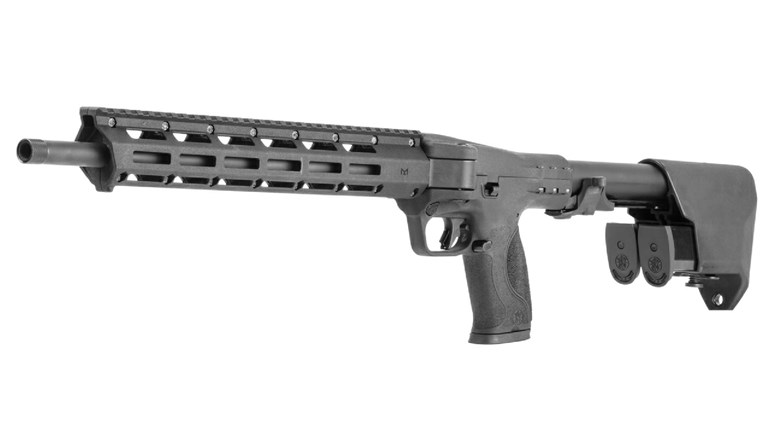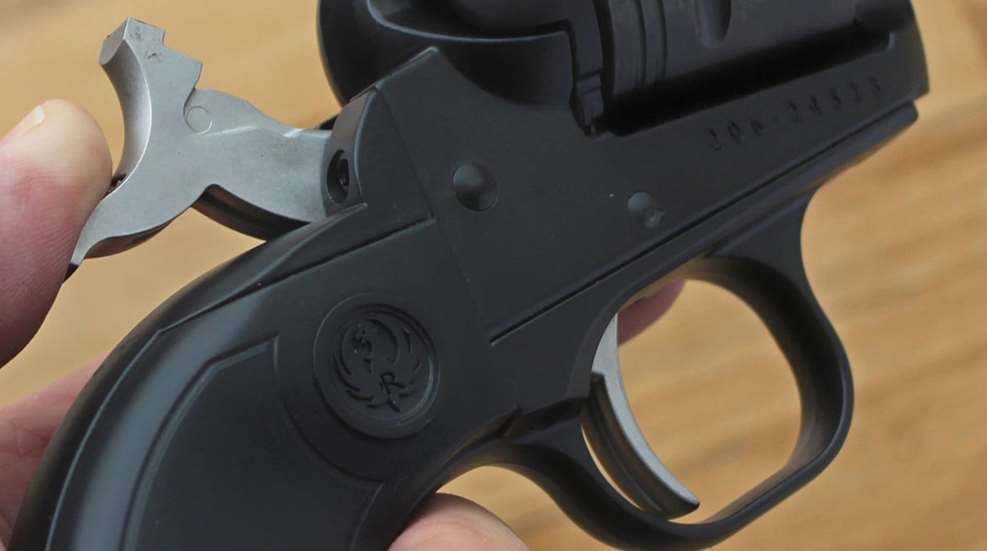
Handgun triggers all do the same thing: when pressed, they make the gun go bang! That's pretty straight forward. However, not all handgun triggers are the same. The internal mechanisms (linkages) and hammers they are connected to operate differently depending on the handgun's design. And it’s these differences in trigger configurations, or trigger types, that directly influence how the trigger feels to the person pressing it and the steps required to operate the firearm properly.
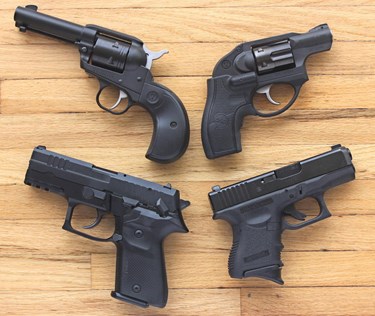
Getting the hang of handgun trigger lingo can be a bit tricky at first because a good deal of it is used to describe revolvers, semi-automatic pistols and various models within those two categories. Two guns can be significantly different in most ways and still share the same trigger type. There are essentially four types to choose from:
- Single-Action (SA)
- Double-Action Only (DAO)
- Double-Action/Single-Action (DA/SA)
- Striker Fired
But before we dive into these categories, let's talk about trigger pull.
Trigger Pull & Trigger Feel
Generally speaking, trigger pull is a measure of how much pressure must be applied by a trigger finger to move a trigger from its starting position to its stopping position. This is also called “cycling” the trigger. In the United States. the pressure is measured using a digital or mechanical trigger gauge with the results shown in pounds and ounces, like this: 5 lbs. 8 oz. The NRA test standard is 10 pulls of the trigger with a gauge and then the resulting weights are averaged together to get a final number. Triggers that require more pressure to operate have a “heavier” trigger pull while those that take less pressure have a “lighter” trigger pull.
Many gun reviews will include descriptions of how the trigger feels. This subjective language doesn't quite fall under the categories of trigger pull (pressure) or trigger type (mechanism). You'll see words like smooth, long, gritty, mushy, short, crisp, clean, and so on. If you are dry firing a pistol's trigger to get a feel for it, pull it slowly, very slowly, quickly and a few times in rapid succession and you'll get a better sense of what gun testers are talking about. It's not uncommon that the feel of the trigger is what makes or breaks the deal for someone considering which gun to buy.
Single-Action Triggers
Single-action triggers (SA) have just one job: to release the hammer so that it can fall forward, strike the firing pin and fire the gun. In order for this trigger to do its job, the hammer must be cocked first in order to create the spring tension needed to drive the hammer forward.
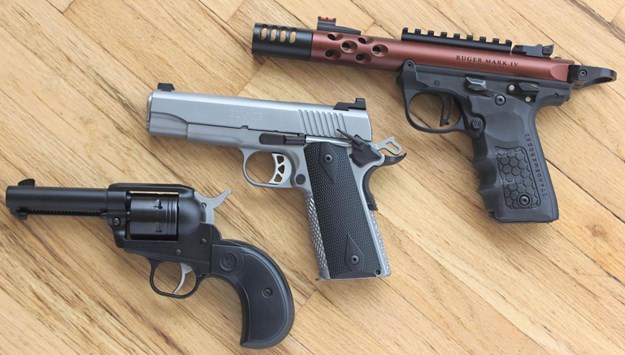
These handguns are quite different from each other in many ways, but all three of them have single-action triggers.
Among the most easily recognized single-actions are the good ol' cowboy revolvers of Old West fame, like the Colt 1873 Single Action Army. You can also find modern updates of these wheel guns, like the Ruger Vaquero or Wrangler (shown). The hammer has a textured extension, called a hammer spur, which is used to cock the hammer with the shooting or support hand thumb.
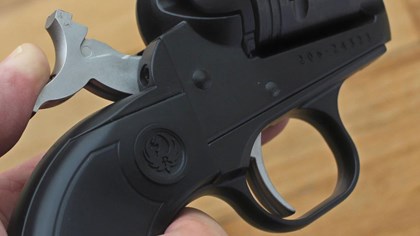
Single-action revolvers like this Ruger Wrangler have exposed hammers that must be thumb-cocked for each shot fired.
The venerable 1911 is among the most well respected single-action, semi-automatic pistols. It too has an exposed hammer with a spur that can be manually cocked. But the hammer is also cocked by cycling the slide. As a round is chambered, the hammer is automatically cocked so that the pistol is ready to fire.
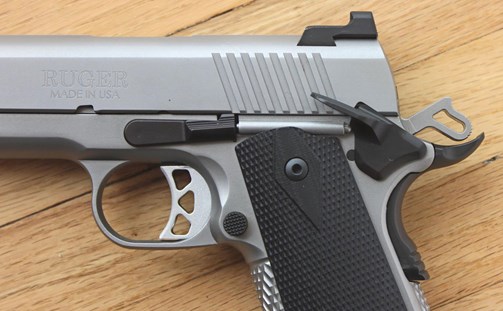
This Ruger 1911 is shown with the hammer cocked and the safety engaged, a.k.a. 'cocked and locked.'
Some single action pistols, like the Ruger Mark IV shown here, have internal hammers without an external spur. The hammer can only be cocked by cycling the slide, or in the case of the Mark IV, by cycling the bolt assembly.
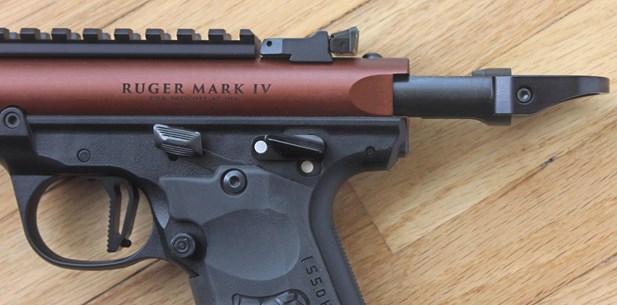
The Ruger Mark IV .22 LR pistol's internal hammer is cocked by pulling the bolt assembly.
The primary advantage of single-action triggers is a light, short, clean trigger pull. It's not uncommon for well tuned triggers of this type to have trigger pull weights of around 5 lbs. or less. Lower trigger weights, along with a shorter trigger arc, makes it easier to keep the handgun on target. They are also enjoyable to use.
Double-Action Only (DAO) Triggers
As the name implies, Double-Action triggers have two jobs to perform. Pulling the trigger cocks the hammer and then allows it to fall forward striking the firing pin. The trade off with hammer-cocking triggers is that the trigger pull is longer and heavier than a SA trigger. DA revolver triggers can weigh in at 12 lbs., or more, while pistol triggers in this class tend to be in the 6-lb. to 9-lb. range. The Double-Action Only (DAO) trigger type means that the hammer is either contained inside the frame or the external hammer does not have a spur. Either way, the hammer cannot be manually cocked for single-action fire.
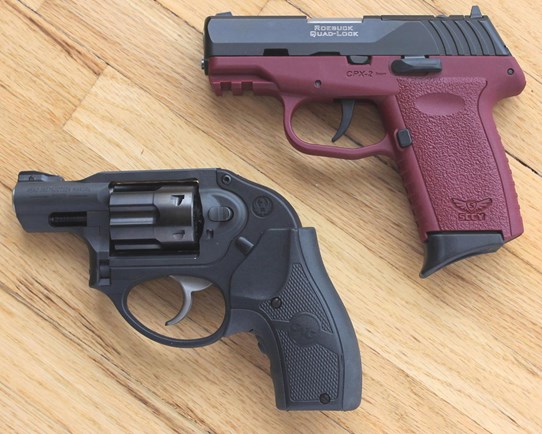
DAO triggers are more commonly found in handguns designed specifically for concealed carry and self-defense.
A heavier trigger pull and no access to the hammer may sound like disadvantages at first blush. But some schools of thought treat them as safety features. When a self-defender is under duress, and their fight-or-flight response is pumping their system full of adrenaline, fine motor skills go out the window. It's possible in these situations to press the trigger harder than one might during practice sessions at the range or to essentially flinch-fire the handgun. With a heavier trigger, the person pulling it needs to make a more deliberate effort to fire the gun, or at least that is the intension behind the design.
Generally speaking, DAO triggers tend to be reserved for handguns designed specifically for daily concealed carry. A DAO trigger eliminates any decision-making processes when using the gun for self defense. There is only one trigger mode to work with, so the trigger pull is consistent for every shot fired and the owner practices with the same trigger pull that they will use in the field. The logic behind eliminating a hammer's spur is to smooth or round off the rear of the frame. No spur lends to a snag-free profile for guns drawn from concealment, like a pants pocket or an inside-the-waistband holster.
Double-Action/Single-Action (DA/SA) Triggers
The Double-Action/Single-Action trigger type is intended to give handgun owners a more flexible, best-of-both configuration. These revolvers and pistols can be fired with either the longer and heavier Double-Action trigger pull, or a lighter and shorter Single-Action trigger pull depending on the owner's preferences.
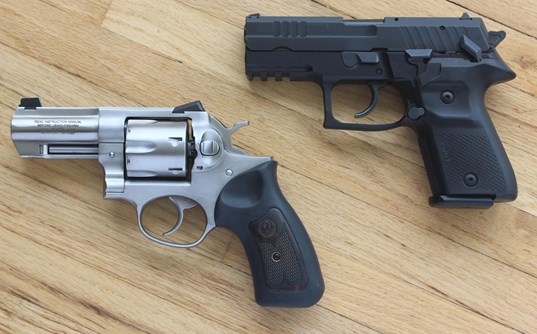
DA/SA triggers allow the shooter to switch between trigger pull weights.
Although revolvers in this class technically have DA/SA triggers, they are usually referred to as Double-Action Revolvers. One reason for this is because the double-action trigger mode is the default setting for these guns. Every pull of the trigger will be the longer, heavier, hammer-cocking trigger pull unless the person shooting the revolver opts to manually cock the hammer and switch the trigger over to single-action mode. The hammer must be manually cocked each time the SA trigger is used. The double-action revolver with this trigger and hammer set up is by far the most popular multi-purpose configuration.
If there is a downside with these revolvers, it's the temptation to practice with the more pleasant SA trigger most of the time. But in the field, the DA trigger is the mode most likely to be used when a shot needs to be fired sooner than later. It's important to practice with both trigger modes in order to be familiar with how they affect the revolver’s handling.
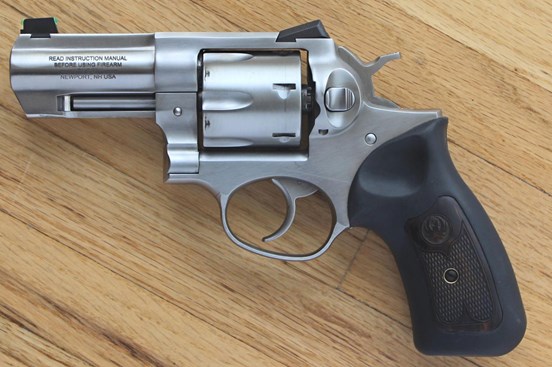
The double-action-revolver design, like the Ruger GP100, is the most popular for general purpose use including self-defense, handgun hunting and target shooting.
Semi-automatics with DA/SA triggers are the Starbucks of the pistol world. They are available with several different control configurations which are too numerous to list here. In addition to triggers with double-action and single-action modes, these guns can have hammers with spurs or without. Some have thumb safety levers, others do not. They can also have what are called de-cocking levers. Pressing this lever allows the cocked hammer (SA mode) to fall forward without firing the pistol in order to reset the trigger to DA mode. Sometimes the de-cocker is an independent control (that's all it does) but sometimes the de-cock function is integrated into the thumb safety lever or the slide stop.
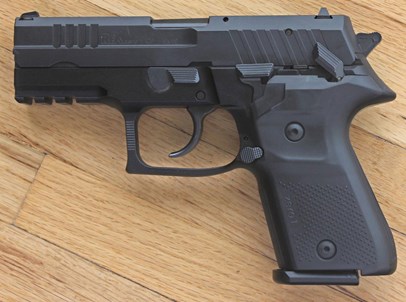
The DA/SA Arex Rex Zero 1 pistol has a hammer spur, a thumb safety and a slide-stop lever, which also serves as a de-cocker.
The DA/SA Arex Rex Zero 1 pistol shown here has hammer spur, which allows it to be manually cocked, and an ambidextrous thumb safety lever. The slide-stop lever (just in front of the thumb safety) also serves as a de-cocking lever. With this particular control configuration, the pistol can be staged in the following three ways:
1. Hammer Forward, Thumb Safety Engaged
This configuration requires more steps to fire. The thumb safety is disengaged. The first shot fired is a double-action trigger pull. The rearward movement of the slide ejects the spent cartridge casing and cocks the hammer. Each subsequent shot is fired with a single-action trigger pull.
2. Hammer Forward, Thumb Safety Disengaged
The gun is fired by pressing the trigger which is in double-action mode. Each subsequent shot is fired with a single-action trigger pull.
3. Cocked & Locked
The hammer is cocked and the thumb safety engaged (like a 1911). When the thumb safety is disengaged, the first and subsequent shots will be fired with the single-action trigger pull.
The upside of a DA/SA pistol trigger is also the downside. So many variations can lead to consistency issues. It can be more of a challenge to master down-range accuracy with a pistol that switches its trigger pull. It's also important to decide how the gun is going to be staged and stick with those settings. In a defensive situation, there's rarely time to think about whether or not the gun's safety and trigger are set to the condition you are used to using.
Striker Fired Triggers
The complexities of DA/SA semi-automatic pistol operations has played a role in driving the popularity of easy to operate striker-fired triggers with civilians, law enforcement and military personnel alike. The mechanical differences between hammer-fired pistols and striker-fired pistols is the topic of another article (click here). For this conversation, let's stick to how these triggers pull.
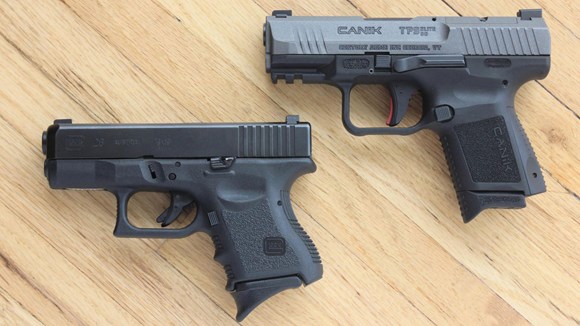
The striker-fired triggers of pistols like the Glock G26 (left) and Canik TP9 (right) are popular because of their easy operation and consistent trigger pull.
Striker-fired triggers are essentially designed to replicate the simplicity of double-action-only triggers: draw, press, repeat. In fact, some manufacturers call their striker triggers double-action triggers in their catalogs. They are currently the most popular type of trigger used with defensive pistols that have light weight polymer frames.
The only external safety on many models is a little lever integrated into the trigger itself. This trigger mounted safety, along with some internal safety mechanisms, prevent the pistol from firing unless the trigger is pressed. Therefore, no other external safety levers or buttons are required. Just press the trigger and the gun fires. No fuss, no muss, and the trigger pull weight and feel is the same for every shot fired. In addition to being consistent, striker triggers usually have lower trigger pull weights than DAO triggers. A common weight is 5 lbs. 8 ozs., which is a standard pull weight for Glock pistols. But they can be lighter if tuned properly.
Once again, the upside of this trigger, its simplicity of operation, is also the downside. If the trigger is pressed, the gun will go off. A carelessly placed trigger finger or a foreign object, like a tree branch or a loose article of clothing, can potentially engage the trigger and cause an unintentional discharge. Some companies have added external thumb safety levers to their striker pistols to address this concern. Critics of this trigger are also quick to point out that many pistols that use this system require the trigger to be pressed as part of the disassembly procedure. However, some manufacturers have tweaked their designs so that no trigger press is required for routine maintenance.
Parting Shots
Although you can find well made and poor constructed examples of each of these hand gun trigger types, no one type is necessarily superior to any other. Each one has its advantages and learning curve. The key is to find a trigger type that best suits your needs and then taking the time to get to know it with regular practice sessions. Whenever possible, it's a good idea to try before you buy.












